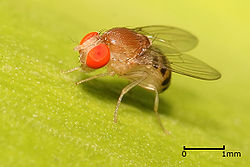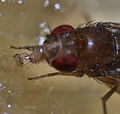- Drosophilidae
-
Drosophilidae 
Drosophila sp. Scientific classification Kingdom: Animalia Phylum: Arthropoda Class: Insecta Order: Diptera Suborder: Brachycera Section: Schizophora Subsection: Acalyptratae Superfamily: Ephydroidea Family: Drosophilidae Subfamily Drosophilidae is a diverse, cosmopolitan family of flies, which includes fruit flies. Another family of flies called Tephritidae also includes fruit flies. The best known species of Drosophilidae is Drosophila melanogaster, within the genus Drosophila, and this species Is used extensively for studies concerning genetics, development, physiology, ecology and behaviour. This fruit fly is mostly composed of post-mitotic cells, has a very short lifespan, and shows gradual aging. As in other species, temperature influences the life history of the animal. Several genes have been identified that can be manipulated to extend the lifespan of these animals.
Contents
Economic significance
Generally, drosophilids are considered nuisance flies rather than pests, since most species breed in rotting material. Zaprionus indianus Gupta is unusual among Drosophilidae species in being a serious, primary pest of at least one commercial fruit, figs in Brazil.[1] Another species, Drosophila suzukii, infests thin-skinned fruit such as raspberries and cherries and can be a serious agricultural pest.[2] Drosophila repleta larvae inhabit drains and spread bacteria. Fruitflies in general are considered as a common vector in propagating acetic acid bacteria[3] in nature. This often ruins the alcohol fermentation process and can ruin the beer or wine by turning it into vinegar.
Identification
The diagnostic characters for Drosophilidae include the presence of an incomplete subcostal vein, two breaks in the costal vein, and a small anal cell in the wing; convergent postocellar bristles; and usually three frontal bristles on each side of the head, one directed forward and the other two directed rearward. More extensive identification characteristics can be found in "Drosophila: A Guide to Species Identification and Use" by Therese A. Markow and Patrick O'Grady, (Academic Press, 2005) ISBN 0124730523 or "Drosophila: A Laboratory Handbook" by M. Ashburner, K. Golic, S. Hawley, (Cold Spring Harbor Laboratory Press, 2005).
Phylogeny
The knowledge of the phylogeny of this family is incomplete. The family is subdivided in two subfamilies, the Drosophilinae and the Steganinae. The two subfamilies do not contain a single morphological character that distinguishes them. However, the combination of characteristics is sufficient to assign species correctly to the subfamilies.
Most molecular phylogeny studies focus on the genus Drosophila and related genera. Recently, an overview of the more than 100 articles using molecular techniques has been published [4]
Gallery
External links
References
- ^ "Pest Alerts - Zaprionus indianus Gupta, DPI". Florida Department of Agriculture and Consumer Services. http://www.doacs.state.fl.us/pi/enpp/ento/zaprionusindianus.html. Retrieved 2007-10-19.
- ^ Drosophila suzukii Center of Invasive Species Research
- ^ Vinegars of the World. Chapter 5. ISBN: 978-0-470-0865-6
- ^ van der Linde, Kim; Houle, David (2008) A supertree analysis and literature review of the genus Drosophila and closely related genera (Diptera, Drosophilidae). Insect Systematics & Evolution 39(3): 241-267
Categories:- Drosophilidae
- Insect families
Wikimedia Foundation. 2010.




